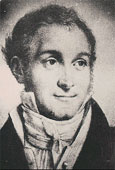Pierre Berthier
Pierre Berthier (born July 3, 1782 in Nemours , † August 24, 1861 in Paris ) was a French geologist and mineralogist .
Life
He studied at the École polytechnique (doctorate 1798). In 1801 he went to the École des Mines , where he became an engineer. In 1821 he discovered a mineral in the village of Les Baux de Provence in the south of France , which was named bauxite after the first place where it was found and which is an ore of aluminum . In 1827 he found and described another, hitherto unknown mineral, which Wilhelm Ritter von Haidinger named after him Berthierite . His studies on phosphates were of great importance for the development of agriculture , where they are used as fertilizers .
In 1827 Berthier was elected to the French Academy of Sciences and in 1829 as a corresponding member of the Prussian Academy of Sciences . In 1828 he was named a Knight of the Legion of Honor. He was also immortalized by name on the Eiffel Tower as one of 72 scientists and engineers .
In 1821, Berthier was the first to discover that the addition of chromium leads to stainless steel, which at that time could not, however, be evaluated technologically, as the alloy was too brittle.
Web links
- Detailed biography and works in French
- Article by / about Pierre Berthier in the Polytechnisches Journal
- Information on Pierre Berthier in the database of the Bibliothèque nationale de France .
Individual evidence
- ↑ Pierre Berthier: Berthierite - a new mineral species. In: Annalen der Physik , 1827, 11, pp. 478-482 ( full text ).
- ↑ List of members of the Académie des sciences since 1666: Letter B. Académie des sciences, accessed on September 15, 2019 (French).
- ^ Members of the previous academies. Pierre Berthier. Berlin-Brandenburg Academy of Sciences and Humanities , accessed on February 21, 2015 .
- ↑ Derek Lowe, Das Chemiebuch, Librero 2017, p. 250
| personal data | |
|---|---|
| SURNAME | Berthier, Pierre |
| BRIEF DESCRIPTION | French geologist and mineralogist |
| DATE OF BIRTH | July 3, 1782 |
| PLACE OF BIRTH | Nemours |
| DATE OF DEATH | August 24, 1861 |
| Place of death | Paris |
